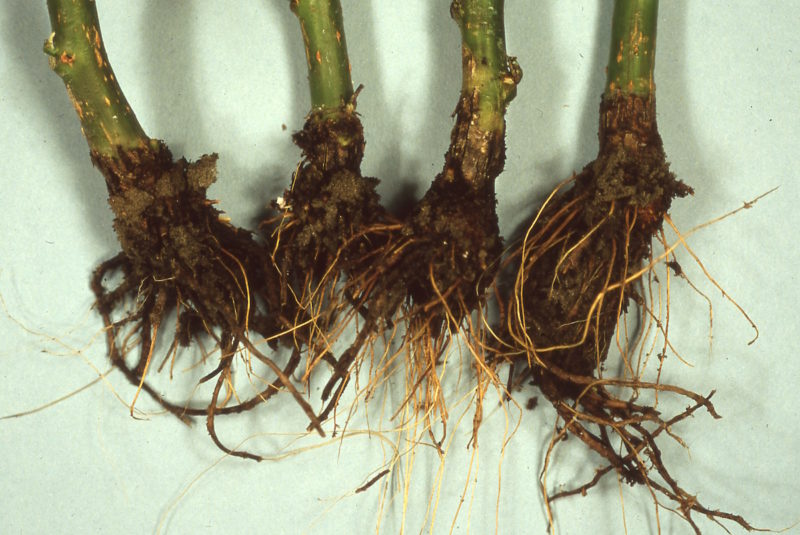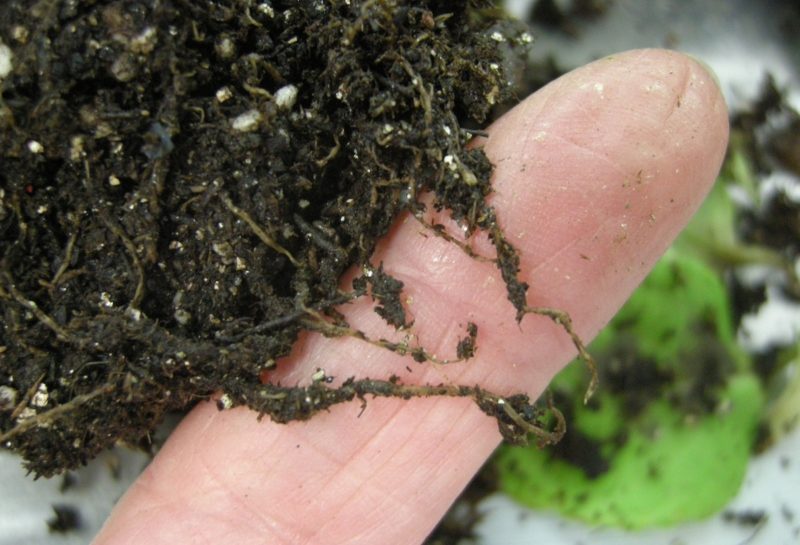
Keeping Up with Root Rots — Berkeleyomyces Is the New Black
Usually root rot diseases are detected a few weeks after transplant, because the strong growth of the healthier plants makes it obvious that there is something WRONG with the ones that are being parasitized by a root rotter. The most common above-ground manifestation of root rot in your crop is an uneven stand. If you notice some plants looking great and others looking miserable, check for root rot by knocking plants out of their pots to take a look. Better yet, examine roots of your crops regularly to keep track of the health of the root systems.
Two categories of microorganism can lead to root rot in your plants: fungi and water molds. Because uptake of water and nutrients is disrupted by the infection, affected plants are stunted to various degrees, depending upon when they were infected — leading to that uneven look. Early indications include yellowing, purpling or graying of leaves, but eventually plants may slow their growth, wilt and die. Here are tips on how to outwit the six most common root rotters in the greenhouse.
Black root rot. The fungal root rot that we see most often is the one we used to call Thielaviopsis root rot. It was, and still is, also known as black root rot. Taxonomists have recently assigned a new name to the pathogen: Berkeleyomyces basicola rather than Thielaviopsis basicola. Just call it black root rot, and you’ll never need to worry about going out of fashion. The new name honors Miles Joseph Berkeley, an Englishman born in 1803 who was one of the founders of plant pathology. This fungal pathogen has been particularly troublesome on calibrachoa, petunia, poinsettia, vinca, pansy and viola.

If your pH is high, 6.0 or above, that favors black root rot. When we conduct experiments in which we want disease so we can evaluate control measures, we lime heavily. Growers battling black root rot should use a pH in the mid-to-low 5s for the susceptible crops.
This fungus is often correlated with poorly draining mix and fungus gnat activity. Fungus gnat larvae can feed on a black-rotted root system, pupate, and then spread the causal fungus in their frass when they fly out as adults. Basil plants are not troubled by B. basicola in the field or in containers, but black root rot can be severe in hydroponic greenhouse crops of basil. The endospores produced by the fungus are easily moved with circulating water.
Once black root rot has struck a crop, it is extremely important not to reuse the flats, trays or pots for a later round of production of a susceptible plant. The fungus makes chlamydospores for long-term survival, and these will remain stuck onto plastic surfaces unless they are physically dislodged. Peroxide-, quaternary ammonium- or bleach-based disinfectants will sanitize surfaces to inactivate B. basicola inoculum.
Fusarium root rot. Some Fusarium species (e.g., Fusarium solani) can serve as root rotters without causing systemic infection. Fusarium, like Berkeleyomyces, is favored by overly wet soils, so good cultural conditions including well-drained mix will help to keep it from being a problem. Fusarium root rot is also triggered by overfertilization, especially with an ammonium-based fertilizer. Should you encounter a problem with a Fusarium root rot, try switching to a different mix with better drainage properties, and consider a calcium nitrate-based fertilizer.
Rhizoctonia root rot. Rhizoctonia solani, long known as a damping-off, web blight and stem canker perpetrator, can also cause root rot. It is important to keep field soil out of contact with a crop grown in a soilless mix, because soil often contains Rhizoctonia. Although stem base cankers are the forté of this pathogen, root rot is within its repertoire, particularly on woody plants such as azaleas and poinsettias. Overwatering is not necessary to trigger Rhizoctonia root rot. This disease is more an indication of a sanitation lapse.
Cylindrocladium root rot. The fungus Cylindrocladium scoparium, now renamed Calonectria cylindrospora, can cause root rot on many plants including roses, azaleas, mums, myrtle, nandina, dianthus, cuphea, geranium and eucalyptus. It can be hard to eradicate because it forms long-lasting microsclerotia that persist in organic debris on containers or benches. This fungus is favored by excess soil moisture. On azaleas, it causes leaf spots and stem infections, as well as root rot. Cylindrocladium root rot symptoms show primarily in warm seasons of the year: in culture, the fungus grows best at 77 to 86° F.

Pythium and Phytophthora root rots. Root rot may also be generated by water molds, particularly Pythium, Globisporangium (a number of renamed Pythium species) and Phytophthora. These are not true fungi, and thus they require treatment with different chemicals. They form swimming spores called zoospores, so hydroponic culture is ideal for these pathogens. Phytophthora species or Pythium myriotylum, P. aphanidermatum, Globisporangium ultimum, G. irregulare or G. cryptoirregulare can attack flower, vegetable or herb crops. When these pathogens find temperature suitable, they can infect roots in situations where water is abundantly available.

Overfertilization, overwatering and any root stress (such as a dry-down) may promote the development of water mold root rot. Geraniums, poinsettias, mums, coleus, New Guinea impatiens and many other crops are known to be Pythium-susceptible; Phytophthora species show more host-specialization.


 Video Library
Video Library 




















